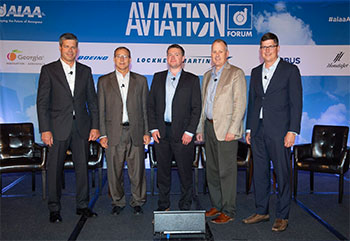The Future of Commercial Supersonic Flight Written 29 June 2018
Panelists: Moderator Robbie Cowart, director, supersonic technology development, Gulfstream Aerospace Corp.; Mike Hinderberger, senior vice president of aircraft development, Aerion Corp.; David Richardson, director for air vehicle design and technology, Advanced Development Programs, Lockheed Martin; Blake Scholl, founder and CEO, Boom Supersonic; Kevin Welsh, executive director, Office of Environment and Energy, FAA
by Tom Risen, Aerospace America Staff Reporter (2017-2018)

Executives from companies aiming to manufacture a new generation of supersonic airliners and a representative from the FAA working to create regulations to enable them to fly over land spoke about their efforts June 29 during the “A Path to Supersonic Commercial Travel” panel discussion at the 2018 AIAA AVIATION Forum in Atlanta.
The British Airways Concorde, which stopped doing commercial supersonic flights in 2003, only flew over oceans because commercial planes in European and U.S. airspace are forbidden from breaking the sound barrier over land to prevent community disturbance from a sonic boom.
Mike Hinderberger, senior vice president of aircraft development at Aerion Corp., said his company plans to begin offering flights by targeting the business jet set the Concorde catered to.
“We would love to go Mach 2 and Mach 2.5,” Hinderberger said of the Aerion AS2. But, he said, Mach 1.4 will be the super cruise speed of the plane because it would balance fuel burn to enable better range and limit noise. Aerion aims to fly the AS2 in 2023 and deliver to customers in 2026. The company is working with Lockheed Martin to design and develop the plane.
NASA has also contracted Lockheed Martin’s Skunk Works to design, build and do initial test flights of the agency’s newly named X-59 low-boom supersonic demonstrator aimed at reducing the noise of a sonic boom. David Richardson, director for air vehicle design and technology at Skunk Works, said NASA and the FAA have a “once in a generation shot” to certify commercial supersonic aircraft to fly over land.
“If we don’t get it right, right now I don’t think we are going to be able to do this again in 30 years; someone will say, ‘look at what happened back then,’” Richardson said.
There are landing and takeoff noise standards to certify subsonic planes, and one was specifically written for the Concorde, but none exist for new commercial supersonic planes other than a provision for testing. The pace of how that new certification process unfolds “is going to be critical in the design, development and advancement of these aircraft.”
said Kevin Welsh, executive director of the FAA’s Office of Environment and Energy.
Blake Scholl, founder and CEO of Colorado-based Boom Supersonic, said his company is among the firms aiming to do commercial flights over oceans until regulations enable flights over land. To avoid certification snags with the Boom supersonic airliner, Scholl said, “we have a rule — no new technology on the plane if it has not been certified.”
